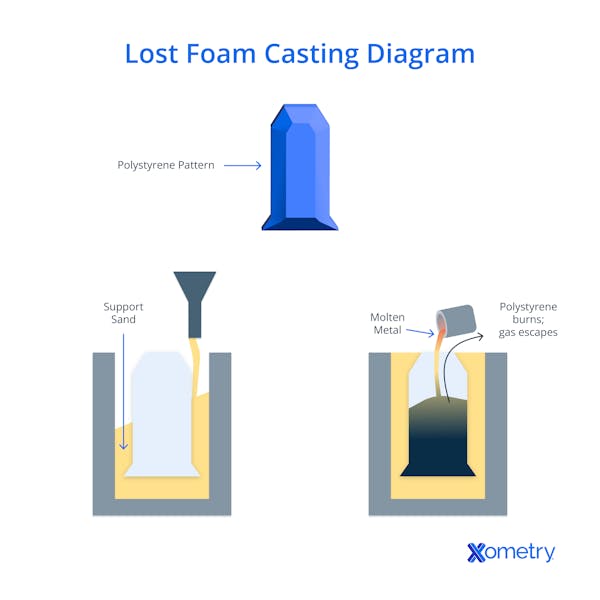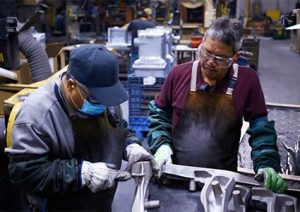Aluminum Foundry Wisconsin plays an vital place in casting projects
Wiki Article
Exactly How Aluminum Foundry Adds To Advancements in Aerospace Design
Aluminum foundries are integral to improvements in aerospace engineering. They produce lightweight, high-strength parts that are vital for modern aircraft. Via advanced casting techniques, these factories develop complex geometries that boost architectural integrity. In addition, the development of remarkable Aluminum alloys supports the market's concentrate on gas effectiveness and sustainability. Nonetheless, challenges stay in the production procedure. Recognizing these variables discloses the profound influence of Aluminum on air travel's future.The Relevance of Lightweight Materials in Aerospace Style
As the aerospace industry remains to advance, the relevance of light-weight materials becomes increasingly obvious. The need for efficiency and sustainability drives engineers to focus on the usage of materials that decrease general weight without jeopardizing architectural integrity. Lightweight materials, specifically Aluminum, play a vital duty in boosting fuel performance, boosting haul capacity, and enhancing the overall efficiency of airplane.Furthermore, the combination of these products enables innovative designs, making it possible for producers to create even more aerodynamic shapes that can endure extreme problems. The decrease in weight not just decreases functional prices yet additionally adds to a decreased environmental footprint, lining up with global initiatives toward sustainability in aeronautics.
Advanced Spreading Techniques in Aluminum Foundries
Advanced casting techniques in Aluminum shops play a vital role in aerospace design by making it possible for the manufacturing of light-weight and specific elements. Innovations in mold layout and precision casting processes are important in achieving suitable performance and architectural stability. Additionally, the growth of lightweight alloys boosts the overall performance and efficiency of aerospace applications.Innovative Mold And Mildew Style
Cutting-edge mold and mildew style plays an essential role in the effectiveness and effectiveness of Aluminum factories, particularly within the aerospace market. By leveraging sophisticated materials and techniques, contemporary mold and mildews can be crafted to stand up to heats and pressures, making certain peak performance throughout the spreading process. These styles usually integrate intricate geometries that permit the manufacturing of light-weight yet structurally sound elements, essential for aerospace applications. Furthermore, the usage of computer-aided design (CAD) software program facilitates exact modeling, making it possible for factories to mimic and improve mold designs before physical manufacturing begins. This not only enhances the high quality of actors parts however additionally reduces waste and lead times, bring about significant cost savings. Overall, innovative mold and mildew layout is a foundation of development in Aluminum Foundry technology for aerospace engineering.Accuracy Casting Procedures
The performance of innovative mold and mildew layouts perfectly integrates with accuracy casting procedures, which are crucial for generating top quality Aluminum components in aerospace design. These procedures, consisting of sand spreading, pass away spreading, and financial investment casting, ensure the development of complicated geometries with limited resistances. Advanced strategies like vacuum cleaner casting and stress die casting boost the honesty and surface finish of the final products. Accuracy casting lessens material waste while taking full advantage of the mechanical residential or commercial properties of Aluminum, crucial for aerospace applications. Furthermore, using real-time surveillance and advanced simulation tools throughout the casting process permits prompt modifications, resulting in improved quality assurance. Collectively, these precision spreading processes position Aluminum shops at the leading edge of aerospace advancement, supporting the sector's demand for reliability and efficiency.Lightweight Alloy Development
As aerospace designers seek to boost fuel efficiency and efficiency, light-weight alloy advancement comes to be a vital emphasis in Aluminum shops. These foundries use innovative casting strategies to develop alloys that offer superior strength-to-weight proportions. Technologies in alloy structure, consisting of the consolidation of elements like lithium and magnesium, allow the production of products that withstand severe problems while decreasing total aircraft weight. Methods such as die casting and financial investment spreading help with the accuracy manufacturing of complicated shapes, which are essential for aerospace applications. Additionally, recurring research study intends to optimize these alloys for enhanced mechanical buildings and enhanced longevity. By prioritizing lightweight alloy development, Aluminum factories greatly add to the advancement of aerospace design, leading the means for more effective and lasting airplane designs.
Enhancing Structural Integrity With Aluminum Parts
Aluminum components offer significant benefits in boosting architectural stability within aerospace engineering. Their lightweight nature contributes to overall efficiency while keeping toughness, which is crucial for airplane efficiency. In addition, the stress and anxiety resistance properties of Aluminum aid assure the resilience and dependability of aerospace structures under various operational conditions.
Lightweight Material Conveniences
While conventional materials usually endanger weight for strength, utilizing Aluminum parts in aerospace engineering offers substantial benefits in structural honesty. Aluminum's light-weight nature contributes to general style effectiveness, permitting more streamlined airplane that eat less gas, thereby boosting sustainability. The material's superb strength-to-weight proportion assurances that components maintain resilience without including unnecessary mass. This high quality fosters improved efficiency and agility in trip, as well as optimized payload abilities. Furthermore, Aluminum's resistance to corrosion extends the lifespan of aerospace frameworks, lowering upkeep prices and improving security. As makers increasingly embrace Aluminum alloys, the aerospace industry experiences a transformative shift in the direction of a lot more efficient and effective design remedies that focus on both performance and environmental responsibility.Anxiety Resistance Features
Although numerous products have special buildings, Aluminum's exceptional stress and anxiety resistance attracts attention as a critical aspect in improving the structural honesty of aerospace elements. This resistance plays a vital duty in ensuring that aircraft can endure different functional stress and anxieties, including exhaustion, effect, and ecological conditions. Aluminum alloys, especially crafted for aerospace applications, display high tensile toughness while preserving light-weight qualities, allowing engineers to make extra effective structures - Aluminum Foundry. Additionally, the capacity of Aluminum to withstand cyclic loading without significant deformation contributes to the durability and reliability of aerospace components. As advancements continue in Aluminum Foundry techniques, the advancement of stress-resistant Aluminum components assures further enhancements in performance, security, and performance across the aerospace industry, solidifying Aluminum's duty home as a preferred product in modern-day engineeringFuel Performance Improvements Driven by Aluminum Innovations
As the aerospace industry seeks to enhance gas efficiency, cutting-edge usages of Aluminum have become a necessary option. Aluminum's light-weight nature notably reduces aircraft weight, enabling reduced fuel consumption during flight. This decrease in weight is crucial, as even small declines can result in significant improvements in total gas economy.Advanced Aluminum alloys, made for improved toughness and durability, allow producers to create parts that maintain structural honesty while reducing mass - Aluminum Foundry. In addition, the integration of Aluminum in airframes and engine parts helps with boosted aerodynamics, contributing to lowered drag and raised effectiveness
The fostering of Aluminum in aerospace not just satisfies the need for fuel-efficient layout but also straightens with regulatory pressures for lower discharges. As these innovations continue to develop, they play a substantial role in setting new benchmarks for fuel efficiency, ensuring that the aerospace industry can satisfy growing financial and ecological challenges.

The Role of Aluminum in Sustainable Air Travel Practices
The boosting emphasis on sustainable aviation practices has actually positioned Aluminum as an important material in the pursuit for greener airplane design. Known for its light-weight residential or commercial properties, Aluminum substantially lowers airplane weight, causing reduced fuel consumption and emissions. Its recyclability further enhances its sustainability account, as Aluminum can be reused forever without loss of high quality. This characteristic supports a circular economy within the aviation field, lessening waste and source deficiency.Improvements in Aluminum alloys have boosted their stamina and rust resistance, enabling for longer service life and lowered maintenance needs. These technologies assist in the development of a lot more efficient aircraft frameworks, adding to general sustainability initiatives. Additionally, Aluminum's thermal conductivity plays a crucial duty in energy-efficient styles, boosting systems such as heat exchangers. Jointly, these attributes highlight Aluminum's crucial role in advancing sustainable aeronautics, aligning with worldwide efforts targeted at minimizing the environmental influence of air traveling.
Difficulties Faced by Aluminum Foundries in Aerospace Manufacturing
While Aluminum shops play a vital role in aerospace manufacturing, they deal with substantial challenges that can influence production performance and quality. One major difficulty is the rigid quality assurance criteria required in the aerospace industry. Any defect can compromise safety and performance, requiring extensive examination procedures that expand production timelines. In addition, shops typically compete with varying basic material expenses, which can affect prices and productivity. The intricacy of Aluminum alloys used in aerospace applications additional complicates the manufacturing procedure, as accurate formulas are critical for attaining wanted mechanical residential properties. In addition, skilled labor scarcities hinder the capability to preserve high-quality manufacturing degrees. Ultimately, environmental laws enforce constraints on discharges and waste management, calling for factories to purchase sustainable methods, which can be cost-prohibitive. These aspects jointly develop a landscape where Aluminum factories must continually adapt to meet the evolving needs of aerospace manufacturing while ensuring safety and security and conformity.Future Trends in Aluminum Applications for Aerospace Design
With improvements in technology and increasing demands for efficiency, the future of Aluminum applications in aerospace engineering is positioned for significant transformation. The combination of innovative Aluminum alloys and compounds is expected to improve strength-to-weight proportions, leading to even more fuel-efficient aircraft designs. On top of that, innovations in additive manufacturing strategies will enable the manufacturing of complicated Aluminum frameworks that were previously difficult, maximizing performance and lowering waste.
Lasting practices will certainly play an essential role, with an expanding focus on reusing Aluminum to reduce environmental influence. The aerospace field is likely to embrace smarter manufacturing processes, such as automation and expert system, guaranteeing higher high quality and accuracy in Aluminum elements. Collaborations between Aluminum shops and aerospace firms will certainly promote research study and advancement, paving the way for brand-new applications that fulfill the rigid demands of contemporary aerospace engineering. On the whole, the future looks assuring for Aluminum's function fit the skies
Regularly Asked Concerns
What Are the Environmental Impacts of Aluminum Manufacturing in Aerospace?
The ecological effects of Aluminum production in aerospace consist of substantial energy usage, greenhouse gas emissions, and environment interruption. Additionally, mining procedures can cause soil deterioration and water contamination, increasing worries about sustainability and eco-friendly balance.Just How Does Aluminum Contrast to Other Products in Aerospace Applications?
Aluminum provides an unique combination of lightweight residential or commercial properties, deterioration resistance, and cost-effectiveness contrasted to various other materials. Its high strength-to-weight proportion makes it especially advantageous for aerospace applications, improving gas effectiveness and overall visit this site efficiency in airplane design.What Certifications Do Aluminum Foundry Workers Need for Aerospace Projects?
click to find out more Aluminum Foundry workers call for specific training in metallurgy and spreading techniques, in addition to understanding of aerospace sector requirements. Certifications in high quality control and safety procedures are additionally important to assure compliance with rigid aerospace task requirements.Exist Any Kind Of Security Worry About Using Aluminum in Aerospace Design?
Safety and security issues pertaining to Aluminum in aerospace design include sensitivity to deterioration, stress and anxiety, and fatigue cracks. Correct therapy and alloy selection are necessary to minimize these risks, making sure architectural stability and general security in aerospace applications.Exactly How Does Aluminum Recycling Advantage the Aerospace Market?
Aluminum recycling considerably profits the aerospace market by minimizing product prices, decreasing ecological impact, and conserving power. This lasting technique enhances the sector's performance while promoting making use of lightweight, high-performance components in aircraft production.Advanced spreading strategies in Aluminum factories play a crucial duty in aerospace engineering by enabling the production of precise and light-weight elements. Ingenious mold design plays an important role in the efficiency and effectiveness of Aluminum shops, specifically within the aerospace industry. As aerospace engineers look for to improve fuel performance and efficiency, lightweight alloy growth ends up being a vital focus in Aluminum factories. Aluminum alloys, particularly crafted for aerospace applications, display high tensile strength while keeping lightweight qualities, making it possible for designers to develop more efficient structures. Partnerships between Aluminum shops and aerospace companies will certainly foster study and development, leading the way for brand-new applications that satisfy the strict needs of contemporary aerospace engineering.
Report this wiki page